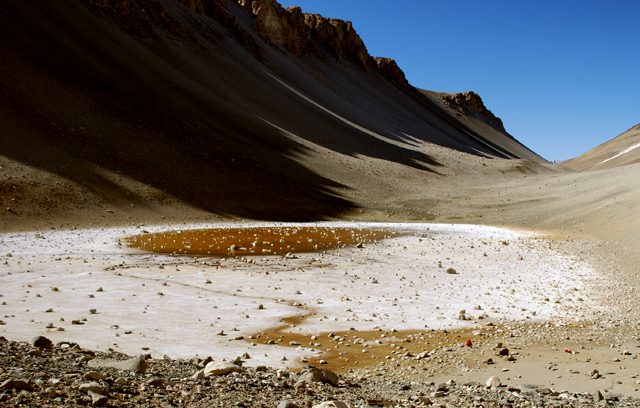No laughing matterAntarctic pond offers insight into greenhouse gas production, Mars explorationPosted May 14, 2010
A high-saline pond in Antarctica may be the source of an important greenhouse gas. Don Juan Pond in the McMurdo Dry Valleys The scientists discovered a previously unreported chemical mechanism for the production of nitrous oxide, an important greenhouse gas. The discovery could also help space scientists understand the meaning of similar brine pools in a place whose ecosystem most closely resembles that of Don Juan Pond: Mars. The research adds an intriguing new variable to growing evidence that there has been — and may still be — liquid water on Mars, a usual prerequisite for the formation of life, according to a press release In many ways, Don Juan Pond is one of the most unearthly places on the planet. An ankle-deep mirror between mountain peaks and rubbled moraine, the pond is an astonishing 18 times saltier than the Earth’s oceans and virtually never freezes, even in temperatures of more than 40 degrees below zero Celsius. “The pond’s soils and brines and the surrounding rock types are similar to those found on Mars,” said Samantha Joye “It provides an ideal location to assess microbial activity in extreme environments. While we did not detect any ‘bio-gases’ such as hydrogen sulfide and methane, we did, surprisingly, measure high concentrations of nitrous oxide, which is normally an indicator of microbial activity. We needed to find out whether a nonorganic process could account for this nitrous oxide production.” Other authors on the paper include Vladimir Samarkin, a research scientist, and Marshall Bowles, a graduate student, also of the department of marine sciences at UGA; Michael Madigan of Southern Illinois University The research was supported by grants from the National Science Foundation’s Antarctic Organisms and Ecosystems Program The pond, which is a roughly 1,000- by 400-meter basin, is the saltiest body of water on Earth, some eight times saltier than the Dead Sea. While researchers more than 30 years ago reported finding abundant and varied microflora of fungi, bacteria, blue-green algae and yeasts, since then such life has been non-existent. Since the depth level and area covered by the pond, which is fed by hypersaline groundwater, have demonstrably varied over the years, this wasn’t unexpected. What did surprise the team was that even without the apparent presence of life, they were able to measure nitrous oxide, perhaps best known to most people as the “laughing gas” used in dental procedures. “What we found was a suite of brine-rock reactions that generates a variety of products, including nitrous oxide and hydrogen,” Joye said. “In addition to Don Juan Pond, this novel mechanism may occur in other environments on Earth as well and could serve as both an important component of the Martian nitrogen cycle and a source of fuel [hydrogen] to support microbial chemosynthesis.” Working in such a beautiful but unearthly area presents stern challenges to researchers, Joye said. “It’s a 40-minute helicopter ride over the McMurdo Sound just to get there,” she said. “Once in the Wright Valley, we enter a tight enclosure with steep, rocky cliffs on both sides, and between them is Don Juan Pond. I believe it must be one of the most beautiful places in Antarctica.” Samarkin agreed. “It has the kind of beauty that rock parks in Japan have,” he said, “except this is made by nature.” NSF-funded research in this story: Samantha Joye, University of Georgia, Award No. 0739516 |



For USAP Participants |
For The Public |
For Researchers and EducatorsContact UsU.S. National Science FoundationOffice of Polar Programs Geosciences Directorate 2415 Eisenhower Avenue, Suite W7100 Alexandria, VA 22314 Sign up for the NSF Office of Polar Programs newsletter and events. Feedback Form |




